The Self-Publishing Industry is Growing Every Year
More and more authors are choosing to self-publish their own books rather than rely on the traditional publishing process. There are benefits to both routes and authors should make that decision based on their skills and comfort with self-promotion.
Scroll down to learn how to go from idea to self-published author. You will find a clear roadmap with specific, practical information on planning, writing, editing, publishing, and marketing your book. We've also included links to download some free books to help you on your way.
The Pros and Cons of Self-Publishing
The greatest benefit of self-publishing is that you get to keep all the income from your books (Yay!). The greatest hurdle to self-publishing is that you are solely responsible for finding your readers and making those sales (Argh!).
As a self-published writer, you’re the CEO of your own business: one that sells books. It’s on your shoulders to make sure your manuscript is the best it can be, to create and manage your author platform, to market your book(s), to manage inventory (if you’re selling print books), and to take care of the financial and administrative aspects of running your company.
For many authors, this is an exciting new challenge. For others, the idea of actively promoting themselves and their book fills them with horror. But it doesn’t have to be scary. There are a thousand ways to promote your book to prospective readers. Each writer just needs to find the tactics that feel right to them.
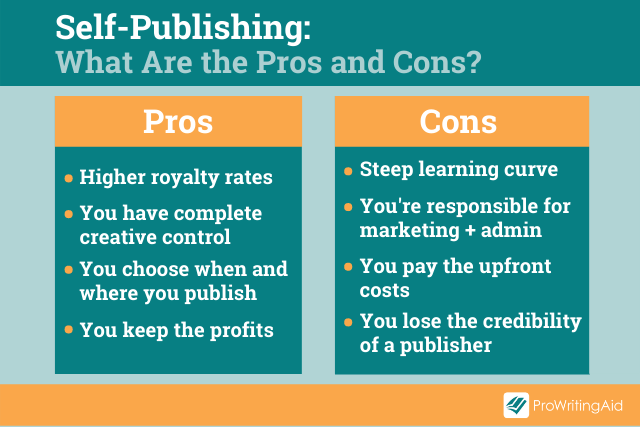
Read on to learn the 12 key steps to becoming a successful self-published author.
Is This the Death of Traditional Publishing?
Of course not. Traditional publishing is still a valid means for authors to get their books into the hands of huge numbers of readers.
Books that are published through traditional methods have the benefit of a large publishing machine behind them. The agents and editors in big publishing houses like HarperCollins or Penguin Random House hold a lot of sway when it comes to getting your book into the big booksellers like Barnes and Noble.
These publishers also have some of the strongest editorial, marketing, and promotion teams out there. This will ultimately lead to greater visibility and reach for your book. They also cover the upfront costs of publishing your book, including an advance.
The downside to traditional publishing is that it is incredibly difficult to break into. The gates are heavily guarded by powerful submissions teams, and if you can’t get past them you don’t get in.
You also lose creative control over things like your cover, blurb, marketing activities, etc. And most importantly, you receive a much lower royalty rate. After the publishing house and agent take their cut, most authors receive around 10% of the royalties on print books, and 30% on eBooks.
What Does the Self-Publishing Process Look Like?
Self-publishing is an ongoing, cyclical process. Many authors have multiple books that are at varying stages, so there can be a lot of balls to juggle.
Each stage is essential—you can’t really cut any corners here. When you’re self-publishing, the work doesn’t end when you have a finished manuscript. In fact, in many ways, it’s just beginning.
12 Steps to Successful Self-Publishing
From story idea to published book, these are the key self-publishing phases that you need to be prepared for:
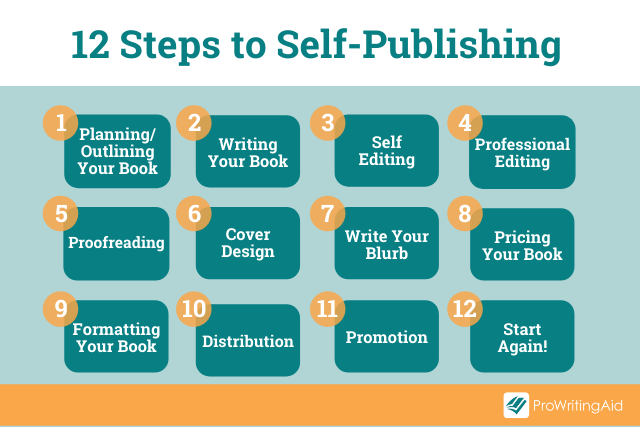
Let's dive in.
1. Planning/Outlining Your Book
Before you publish your book, you have to write it.
Whether you’re a plotter or a pantser, it’s important to have at least a loose plan down for your book.
Here are some key questions to consider:
- What is your main goal for writing your book? Is it money, fame, personal branding, or do you just have a story inside you that is bursting to get out?
- What is your book about?
- What genre are you writing?
- Who are your main characters or what is your main subject?
- What are your key narrative structure and plot points?
- If you are writing non fiction, what level of knowledge will your readers already have?
- What research do you have to undertake in preparation for writing?
- When do you hope to have your manuscript completed?
- Who are your target readers?
Getting these details down on paper will help you during the writing process. As lovely as it would be, most writers don’t have a cozy cabin in the woods that they can disappear to in order to write undisturbed.
Even a loose plan will help you take advantage of the writing time you do have in your real life so you know exactly what to focus on during the minutes of writing you can squeeze between your other obligations.
2. Writing Your Book
How you write will depend largely on your availability and writing style. You might have large chunks of interrupted time to dedicate towards writing or you may need to sneak in a few sentences here and there on your coffee breaks. Either way, it’s important to build a schedule and try to adhere to it.
Be realistic about what you can achieve. You’ll make more headway if you schedule your writing in a way that makes sense for your lifestyle. If you only have ten minutes a day to write, that’s okay. Set an appointment for those ten minutes in your calendar so you don’t forget and commit to doing just that every single day.
If you’d rather work one day a week for a longer chunk of time, that’s fine, too. Many writers get burned out trying to overcommit. The key is to commit at a level where you can still make progress without setting unrealistic expectations for yourself.
3. How to Self-Edit Your Book
Self-editing is a crucial stage for all authors. We have all read self-published work that’s full of grammar mistakes, confusing characterization, and awkward phrasing. It’s the fastest way to make your reader lose faith in your ideas and interest in your story.
Fortunately, as the author, you are the best person to do a thorough self-edit. You know what you want to say better than anyone else.
During the self-editing stage, you want to examine the characters, plot, language, and style in your book. That way, if you choose to hire a professional editor, they can spend more time focussing on making improvements to your writing that you may not catch.
The types of edits you’ll take on will depend on whether you’re working on a fiction or non-fiction book.
Regardless of what type of manuscript you’ve created, your edits will fall into two stages:
1. Developmental Edits
2. Line Edits
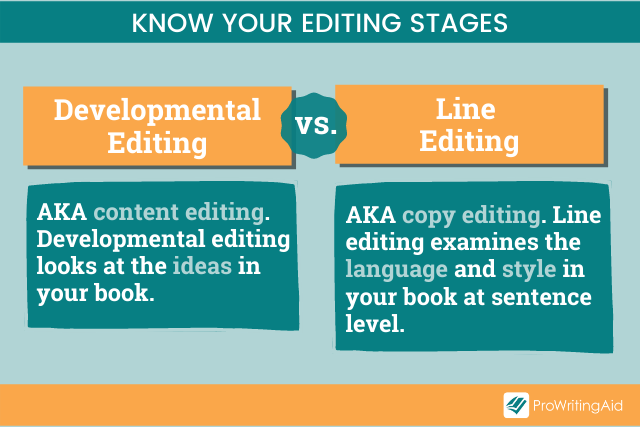
What is Developmental Editing?
Developmental edits are when you look in-depth at the substance of your work. You may have also heard this editing stage referred to as content editing or substantive editing. These terms are all similar: they refer to editing the ideas of your book.
If you’re working on a fiction manuscript, your developmental edits are where you’ll look at your plot, characters, and settings. You may examine your manuscript to see if your settings are vibrant and clear and if your characters have clear motivations and arcs throughout the story. You will also dissect your plot to make sure it flows logically and makes sense.
If you’re working on a non-fiction manuscript, you will take a deep look at your argument during the developmental editing stage. Make sure your writing is clear and persuasive and that you’ve used enough evidence to back up your key points.
What are Line Edits?
After you’ve completed your developmental edits, it’s time to move on to your line edits. You may also have heard this editing stage referred to as copy editing. The goal of the line editing stage is to examine the language and style in your book with a microscope.
Using technology during the line editing stage can help speed up the process. Often, as writers, we don’t notice mistakes or bad habits in our work. An editing tool like ProWritingAid can give you important feedback.
ProWritingAid doesn’t just help you catch mistakes, it helps you improve as a writer by teaching you good writing technique as you edit. When the software suggests a change, there are articles, videos, and even quizzes to help you understand the theory behind the suggestion.
ProWritingAid suggestions are based on techniques you would learn in a university-level writing course.
Tip: Want to try editing software for yourself? Sign up for a FREE ProWritingAid account today.
When self-editing, it’s up to you to make sure you’ve chosen the most effective words, used proper sentence structure, and set up a readable story for your audience.
ProWritingAid’s 20 different writing reports cover everything from bad adverb usage to sentence construction to acronym consistency so you can ensure your prose is polished and error-free when you send your manuscript off to your editor.
To save you time on the editing process and to avoid mistakes as you’re writing, ProWritingAid has integrations for MS Word, Scrivener, GoogleDocs, Chrome , and more so editing can link seamlessly to your writing process.
Here’s what you should focus on during the self-editing stage:
Readability:
Many writers (when they’re just starting out) write in a way that is difficult to follow and understand. Most bestsellers are actually simple and easy to read, not laden down with complicated language and structure. Clear words and sentences will let your ideas shine.
If you’re writing a fiction book, aim for a seventh-grade reading level. This doesn’t mean you need to simplify your ideas, just the words you’re using to get them across.
If you’re writing non-fiction, your desired reading level might be a bit higher, but it’s still important to ensure your work is accessible. Consider which domain-specific vocabulary your reader will understand and which will just confuse them.
Word choice:
In writing, every word counts. As a writer, it’s your job to use a rich and varied vocabulary that is also accessible to your audience. During your self-edit, have a deep look at the words you’re choosing. Are they offering a vivid description for your readers? Can you improve the specificity of your word choices to make your writing more engaging?
Sentence structure:
Clear sentences make clear stories. If your writing isn’t clear at the sentence level, then there’s no way that your overall message and narrative will be clear. When looking at your sentences, here’s what you should ask yourself:
- Am I using passive voice when I could be using active?
- Are any of my sentences overly long and challenging to read? (Reading out loud is a great way to test this.)
- Are most of the words in my sentences essential to the meaning of the sentence?
- Are there places where I can cut out or rewrite sentences that are overly wordy and laden with nonessential information?
4. How to Find an Editor
Once you’ve completed a thorough self-edit of your book, it’s time to call in a professional.
A professional editor might help you flesh out an important subplot or identify places where one of your characters is acting in a way that doesn’t align with their motivations. These edits will help ensure your book is reader-ready.
If this is your first time working with a professional editor, there are a few things you should consider.
First, you should always give editor candidates a sample page to edit before you commit to using their services, even if they come highly recommended. Send them a small excerpt from your book and see what suggestions they send back. Compare the results from several candidates to assess whose suggestions you prefer.
Hiring a professional editor can cost anywhere from $25 to $100+ per hour, with most editors conquering between 2-10 pages per hour.
5. The Importance of Proofreading
The final step in editing is proofreading. Depending on your budget, you may use a professional editor for proofreading or you may use editing technology to make sure your work is free of errors.
Hiring a professional proofreader can cost anywhere from $10 to $100 per hour depending on the experience level of the person you’re hiring. Sometimes proofreaders charge a by-the-word fee of anywhere from $0.01 to $2.00 per word.
There are many places to find professional proofreaders. If you’re budget-conscious, you can compare quotes and find someone in your range on sites like Upwork and Fiverr. You can also find experienced proofreaders through organizations like the Editorial Freelancers Association.
Lastly, never underestimate word-of-mouth referrals. Ask your network which proofreaders they use and love.
6. Book Cover Design
Designing your book cover is an important part of the publishing process. Your book cover is the first impression readers will get of your book. Take the time to research common elements of popular books in your genre. If possible, use the services of an experienced cover designer to ensure your cover is professional and effective.
Bestselling author Nick Stephenson conducted an experiment where he trialled three different book covers for his new novel. By changing out the cover to match readers' genre expectations, he nearly doubled the number of people clicking through to the book page on Amazon. Wowzers.
Your cover doesn’t have to be a detailed work of art. In fact, some of the most iconic book covers are also the simplest.

Learn more about book-cover design: How to Get a Killer Cover Design for Your Book
7. Write a Book Blurb
If your book’s cover is your reader's first impression, then the blurb is what convinces them to purchase it. Your book description needs to be engaging and concise to make readers want to read your book.
A good book description connects potential readers to the characters and settings in your story, drawing them in with vivid details. Your book description should never just be a recounting of important events in your story—save that for a future Wikipedia page. Drop your reader into the action and make it immediately clear who the protagonist is… and what’s at stake if they fail.
If you’re writing non-fiction, you can still focus on the stakes. Ground your book description in the importance of your topic and how it can drive transformation for your readers.
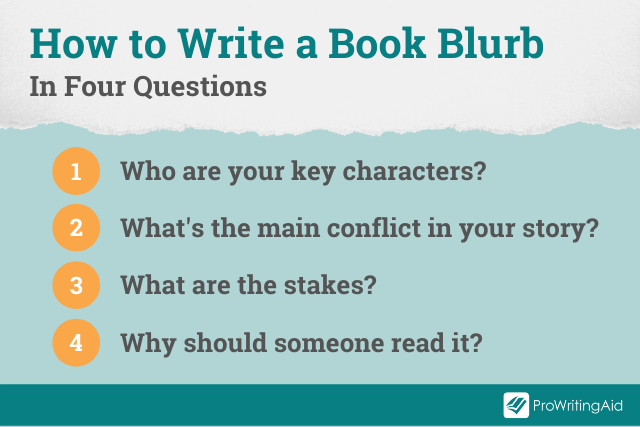
8. How to Price Your Book
Several factors should go into deciding on your book’s price:
- Is this your first book or have you published before?
- How are similar books in your genre priced?
- How many pages is your book?
- What did it cost you to produce this book?
- What kind of income do you want to make from your book sales?
Depending on your ultimate goal as an author, you may even decide to give your book away for free.
Sometimes, new authors will give away their first book or the first book in a new series in exchange for readers opting into their newsletter. This exchange can help you build your email list so that you can market subsequent books to more people more effectively. More on this later.
9. How to Format Your eBook for Self-Publishing
In order to publish your eBook, you need to make sure that it is formatted correctly as either a mobi or epub file. Some software (like Scrivener) allows you to export your manuscript in these formats automatically, but if you are writing in other platforms, you will have to do it yourself, or hire someone to do it for you.
Here are some best practices for formatting eBooks:
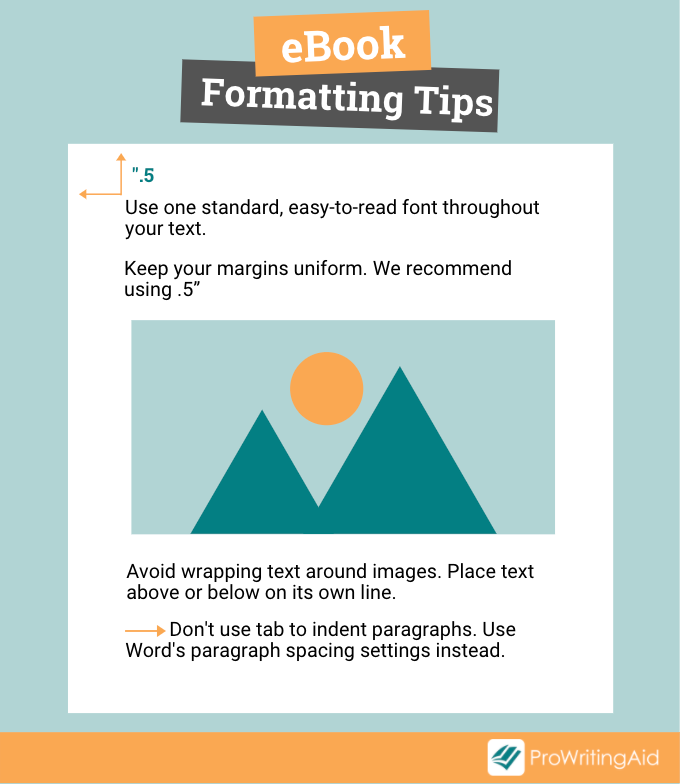
- Use one standard, easy-to-read font throughout your text. Readers can choose the font they want on their eReader, so it’s important to upload in a standard font to ensure there won’t be any conversion errors.
- Keep your margins small and uniform. We recommend using .5”.
- Avoid wrapping text around images. For best results, place text above or below images on its own line.
- Don’t use the tab bar to indent your paragraphs; it will mess up your formatting. Instead, use the paragraph settings in Word to set indents to the first line of each paragraph.
10. How to Distribute Your Book When Self-Publishing
You have two options when it comes to distributing your book.
1. You can upload it directly to online retailers yourself, or
2. You can choose a book distribution service to distribute it for you.
There are benefits to both options, so again, it depends on your experience and the time you have available.
You can publish directly on all of these book distribution platforms:
Book distribution services, on the other hand, take the hassle out of the system. They will get your manuscript up and selling on all the major retailers for you, across various regions of the world.
Payment is usually made as a percentage of sales. Some of the most popular companies offering book distribution services include Ingramspark, Draft2Digital, and Smashwords.
Certain services also offer the ability to print and deliver a physical copy of your book on demand. While many authors choose to just release in eBook format, you can explore this option if it makes sense for you. If you choose a print-on-demand service, the company will take care of printing and fulfilling hard copy orders through sites like Amazon.
All you have to do is upload the finalized version of your manuscript and book cover in the appropriate format and they’ll take care of the rest. This option is useful because it allows you to just print hard copies for people who purchase your book, rather than placing a large upfront order of physical copies and then trying to manage that inventory. Options for this type of service include IngramSpark, KDPPrint, Lulu, and Bookbaby.
Check out this walkthrough of IngramSpark to get more of an idea how it works:
11. Book Promotion Essentials
After you’ve set your book live on the online retailers of your choice, it’s time to start promoting it! There are hundreds of ways you can get readers for your book, but here are some of the most essential.
Build your author platform
Self-publishing authors need to have a website where they can share information about themselves and their books. This is where your fans can find you.
Some authors just go for the bare minimum—bio and books. Others create whole communities around their books’ topic. Some authors blog often, others only occasionally. Some link their books with associated services or affiliate products.
Check out the author pages for other authors that you know and love. What are they doing right? Figure out what is working for them and then create your own version.
Build your email list
We've already alluded to this, but it deserves its own mention because it's just so important.
Every author should spend time building their email list. If someone signs up for your emails, they are essentially asking you to let them know when your next book comes out because they want to buy it. Email lists are like gold dust—treat them with care.
One great way to build your list is to offer something of value for free if they sign up. Maybe you have a short story? Or a helpful guide?
Advertise
Many authors create and run advertising campaigns on Amazon, Facebook, and/or BookBub. It’s a good way to find new readers and stand out among the busy crowds. But it can be expensive, and if you don’t know what you are doing, there is a bit of a steep learning curve. If you are going to advertise, it pays to invest some time learning the ins and outs of digital marketing.
If you’d like more support in building out a structured plan, programs like Draft2Digital, BookFunnel, and Storiad can help you build out a robust promotional calendar.
Outreach
There are lots of ways to find readers through outreach activities. Make connections with people and they are more likely to be interested in buying your book.
- Reach out to bloggers in your genre and offer them a free copy in exchange for a review to their audience.
- Find niche forums and communities on places like Reddit, Quora, Facebook, and Tumblr and run a small promotional giveaway.
- Reach out to other authors in your genre and do joint promotions—you email your list about their book, and they do the same in return.
- Create a profile and then get active in online writer communities like WattPad, NaNoWriMo, and Critique Circle. There are also hundreds of Facebook groups for writers.
Social media
Building up your presence on social media is a great way to keep yourself top-of-mind for potential buyers. If someone has made the choice to follow you, then they are interested in what you are doing and are more likely to buy your book when it’s ready.
Use social media scheduling software like Buffer or Hootsuite to plan your posts. Scheduling in advance means that social media doesn’t become overwhelming.
Don’t just spend every post promoting your books. Mix it up by sharing other content that you enjoyed yourself, like memes or articles related to your book’s topic.
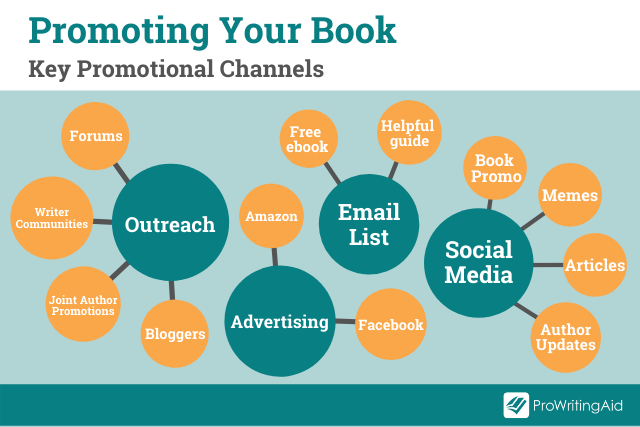
12. Start All Over Again
Your book is complete. You’ve got an amazing cover. It’s live on Amazon and people are buying it. What’s next?
Why, write another book of course! Start the process over. You’ve written one book already. How hard can a second be?
Ready Set Go!
Self-publishing might feel daunting at first, but the benefits are many and varied. Every great journey starts with the first step.
Your story deserves to be heard.
